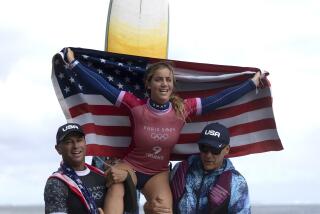Surfing industry sails into uncharted waters
- Share via
Everything old is new again, and that’s good news for the surf industry, which is finding new markets — and new product categories — in a decidedly retro version of surfing.
“The biggest thing in surf right now has got to be stand-up paddling,” said Doug Palladini, president of the Surf Industry Manufacturers Assn. trade group and vice president of marketing for Vans. “It’s becoming a major force in surfing — which is interesting because it’s one of the oldest forms of surfing there is.”
That’s welcome news to an industry that has not been immune to the economic tsunami of the last few years. According to the most recent biannual study commissioned by the Surf Industry Manufacturers Assn. (SIMA), U.S. retail sales in the surf-skate market in 2008 were an estimated $7.22 billion, down 3.5% from $7.48 billion in 2006. Although SIMA won’t have a complete picture of 2010 until the updated numbers are released next year one thing stands out: stand-up paddleboarding is reshaping the surf industry.
In stand-up paddleboarding (or SUP in industry parlance), instead of lying face down and paddling out to catch a wave, a surfer stands upright on the surfboard, and moves with the use of a single, long, oar-like paddle. This means it can be done in marinas, harbors, inland lakes and rivers far from the seacoast. The result, said Palladini, “is we’re seeing it in places all around the world where there’s limited waves, and it’s become a real, meaningful alternative form of surfing.”
Honolulu-based C4 Waterman founded by Todd Bradley and Brian Keaulana in 4 1/2 years ago, specializes in stand-up paddle equipment, and although Bradley declined to give specific sales for the company, he did say sales have increased “exponentially — it’s been triple digits every year,” he said. By way of explaining the reach of the sport, Bradley pointed out that he’d recently returned from the TEVA Mountain Games in Colorado (of which C4 was a sponsor), where he’d been among those to paddle surf Vail’s Gore Creek.
Although initial growth has come on the hardgoods side (in addition to the paddles which start near $200, SUP requires a special, wider board, which starts at around $1,000) makers of soft goods — the T-shirts, boardshorts and accessories that drive the surf industry — report a positive impact in terms of expanded product mix and geographic reach.
“Last summer we opened our first sales account in Missouri,” said Pat Fraley, brand director of Irvine-based Honolua Surf Co.. “And that came as a direct result of the interest in SUP. And these days, I’m actually getting more sales inquiries from outdoor accounts — for SUP on lakes and rivers — than I do from stores on the coasts because we’ve already sold to that customer.”
“This has been a boon for business because it moves this core activity beyond the coasts,” Fraley added.
It’s also broadened the range of clothing options. “A lot of time [traditional] surfers wear a wet suit,” Fraley explained. “But as people get into [SUP], they’re realizing there are certain things that work better; pieces that fit looser, that are cut more like apparel than lycra rash guards.
“One place we’re seeing a ton of stuff is in the tops and in sun protection, primarily in shirts and in hats,” Fraley said. “So we’ve created a line of products that have UV protection.” Last summer Honolua added long- and short-sleeve paddleboarding T-shirts to its offerings with an advertised SPF of 50. A long-sleeve hoodie and a tank-style T-shirt will join the mix next summer.
C4 Waterman’s Bradley also noted that even though stand-up paddlers don’t require SUP-specific apparel, the company is seeing success with offerings such as limited-edition rash guards with Polynesian tribal tattoo designs, called “kaku,” by tattoo artist Keone Nunes. “Our customers are looking for something meaningful that taps into the rich history of Hawaiian and Polynesian culture,” Bradley said. “Our biggest problem is keeping up with demand.”
According to SIMA’s Palladini, an increased attention to, and appreciation of, technical details on the hardgoods side has had an effect when it comes to buying the core piece of the surfer’s wardrobe.
“[Surf retailers] have been aggressively selling $75 to $120 boardshorts when just a year ago they couldn’t sell $50 boardshorts in their stores,” Palladini said. “And it’s because of the amount of technology — the stretch materials, the closure systems, the pocketing systems, the way they’ve been engineered so water flows through them. It’s crossed over from the hardware to the soft-wear side.”
Since the sport has only recently exploded, there are no hard numbers on how much the burgeoning paddleboard business has added at the register — yet. Due to the explosion of the category, a SIMA representative said the group plans to include specific questions about SUP in the next survey, which covers 2010 and is due to be released in the middle of next year.
More to Read
Inside the business of entertainment
The Wide Shot brings you news, analysis and insights on everything from streaming wars to production — and what it all means for the future.
You may occasionally receive promotional content from the Los Angeles Times.











